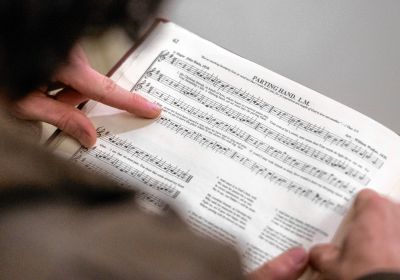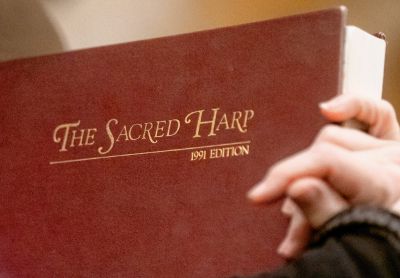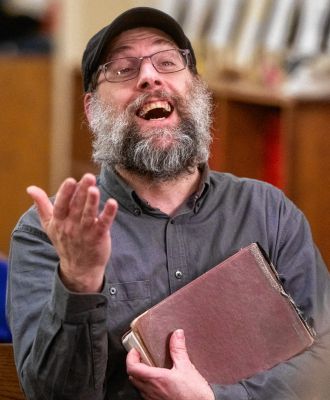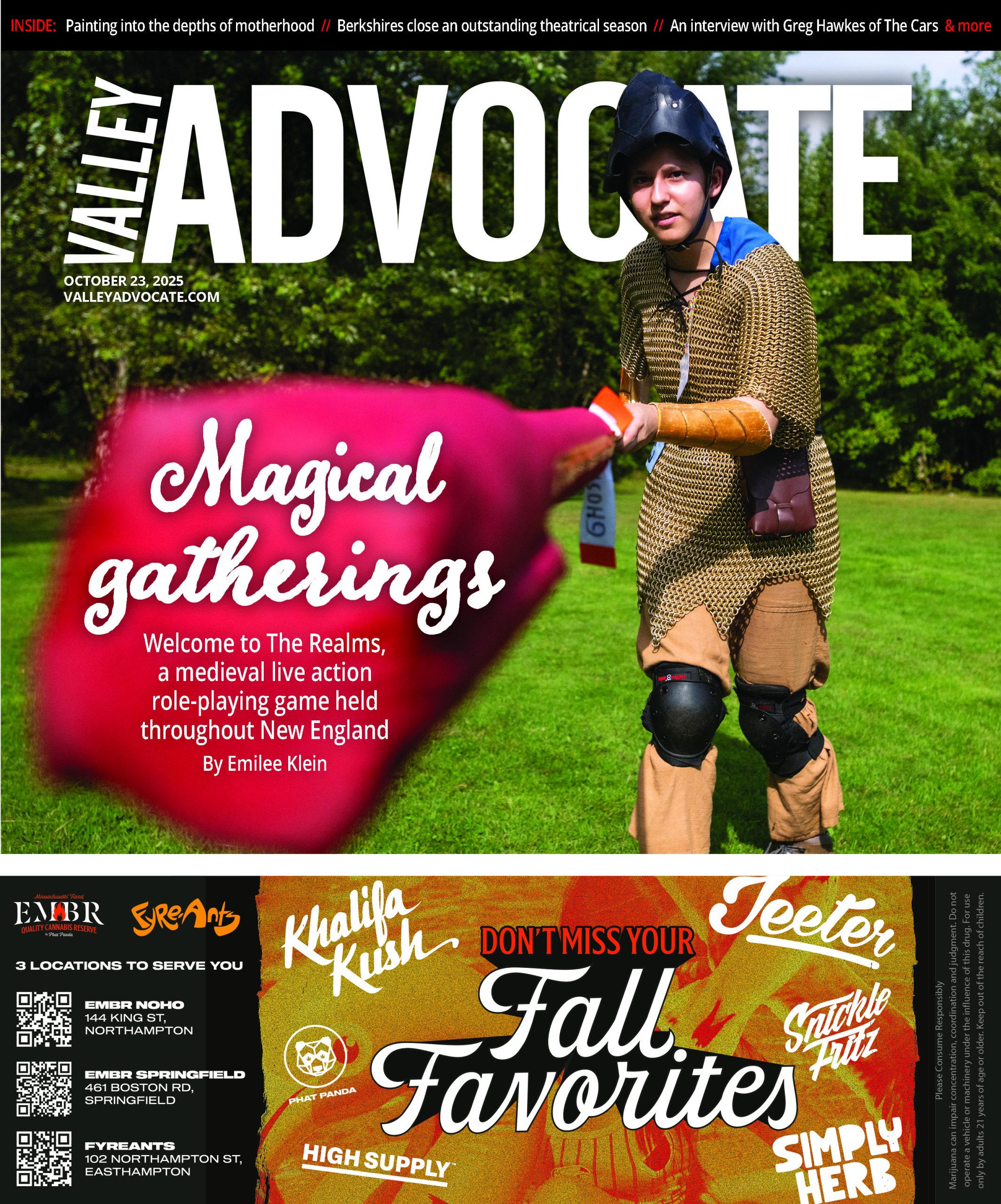By CAROLYN BROWN
Staff Writer
On Saturday, March 8, and Sunday, March 9, the Western Massachusetts Sacred Harp Community (WMSHC) will host their biggest annual event, the Western Massachusetts Sacred Harp Convention, at Bombyx Center for Arts & Equity in Florence from 10 a.m. to 3:30 p.m.

STAFF PHOTOs / DANIEL JACOBI II
Chair of the 2025 Western Massachusetts Sacred Harp Convention Kate Bergren, center, directs the Western Massachusetts Sacred Harp Community during practice at Helen Hills Hills Chapel in Northampton. The convention will take place March 8 and 9 at Bombyx Center for Arts & Equity in Florence from 10 a.m. to 3:30 p.m.
Sacred Harp is a genre of social singing music based around a songbook, “The Sacred Harp,” first published in 1844, whose name refers to the human voice. Most of its songs are Protestant hymns.
Unlike typical choral music, the genre uses a “shape note” form of notation, and, often (but not always), only four notes: “fa” is a triangle, “sol” is an oval, “la” is a rectangle, and “mi” is a diamond. Rather than representing an exact pitch, like G flat or C sharp, each note is relative — a whole step or half step above or below another. When a Sacred Harp group sings a song together, they do so by singing the names of the notes first to get the melody and the pitch, then singing the actual verses.
That may sound confusing, but the style is meant to be helpful to people without prior experience reading sheet music.
“There’s a logic to it,” said musician and historian Tim Eriksen. “There’s a music theory logic to it that nobody thinks about, but there’s also an embodied experiential logic that is part of the practice.” In other words: it’s easier to find a pitch when dozens of people around you are singing it, too.

STAFF PHOTO / DANIEL JACOBI II
Attendees follow along with the sheet music during the Western Massachusetts Sacred Harp Community practice at Helen Hills Hills Chapel in Northampton.
Sacred Harp is tied to Appalachia, but it has roots in Northampton, too, Eriksen said. In the late 18th and early 19th century, Northampton was an important hub of the publishing industry, and a number of hymns that are now part of the Sacred Harp canon were first published in songbooks printed at a printing shop near where Thornes is now. (Northampton, he noted, was abundant with good paper at the time because the first mill on Mill River was made to provide paper for the Gazette.)
At a “singing” — a Sacred Harp get-together in which everyone, well, sings — participants divide themselves into four groups by their vocal parts (tenor, bass, alto, and treble) and sit in an arrangement called “the Hollow Square,” in which one person (a rotating role) “conducts” in the middle. (WMSHC hosts a weekly singing every Tuesday from 7 to 9 p.m. at Helen Hills Hills Chapel at Smith College, plus a monthly singing on the first Sunday of every month from 3 to 5 p.m. at Deerfield Community Center.) Newcomers can also go to a “singing school,” an introductory and educational singing that introduces people to the genre, though it’s not required to take part.
The genre prides itself on being very beginner-friendly. Anuhea Sebstad, a WMSHC member, laughed that as a result of learning Sacred Harp, “I feel like I can read music even though I extremely cannot read music!” Even WMSHC chair Kate Bergren said she felt unsure before she finally took part in a singing, but she changed her mind when she saw a YouTube video of a Northampton singing in which children were leading songs.
“If children are welcome,” she realized, “I, too, am welcome!”
“In my opinion, it’s the best,” Eriksen said. “There’s no soloing. There’s no emphasis on virtuosity. If you can hit one note and hit it hard, you’re good to go.”
The Sacred Harp community, especially in western Mass, tends to be “noticeably pretty queer-friendly,” Bergren said, and is very welcoming overall beyond that.

STAFF PHOTO / DANIEL JACOBI II
Sacred Harp is a genre of social singing music based around a songbook, “The Sacred Harp,” first published in 1844, whose name refers to the human voice. Most of its songs are Protestant hymns.
“It’s just not part of the culture to consider who has a ‘good voice’ and who does not,” she said. In Sacred Harp, “There is no such thing as a ‘good voice.’”
Bergren estimates that the group has between 30 and 50 regular attendees at its weekly singings at the Helen Hills Hills Chapel at Smith College. The group had its highest turnout in recent memory — about 60 people — on Election Night.
“I think everyone was like, ‘I don’t need to sit at home and watch CNN. I want to be out singing,’” Bergren said.
Community members will usually encourage a first-time Sacred Harp singer to sit in the tenor section, which sings the melody, but they don’t have to, even if that’s their vocal part: “Experiment, see what feels good, have fun,” Bergren said.
Bergren first learned about Sacred Harp music through the Civil War movie “Cold Mountain,” starring Jude Law and Nicole Kidman, which uses Sacred Harp in its soundtrack. That entry point turned out to be full-circle: Tim Eriksen, who now sings with WMSHC, worked on the movie as a musical consultant.

STAFF PHOTO / DANIEL JACOBI II
Matthew Wojcik sings during the Western Massachusetts Sacred Harp Community practice.
“Anywhere you go, if you can find Sacred Harp singers and you bring your book, you can sit down with them and sing all day, sometimes before you exchange a sentence or an introduction,” Eriksen said. “It gives you an opportunity to get a glimpse inside somebody before you even pay attention to the outside. Through that bond that comes through singing, it opens the door for a sense of connection with people.”
“It leads to some very interesting and — I was gonna say ‘surprising’ friendships — they’re not surprising to Sacred Harp singers,” he added. “They might be surprising to other people. The short answer is: come one, come all. We love you. Come sing.”
The March 8 and March 9 events are free to attend, and more info can be found at bombyx.live/events.
Carolyn Brown can be reached at cbrown@gazettenet.com.


